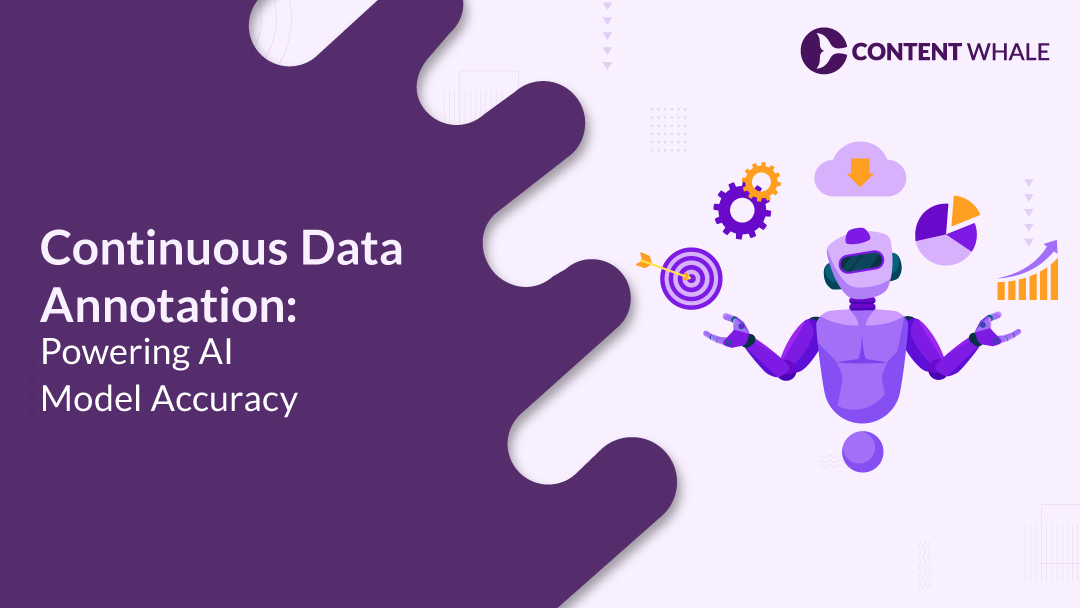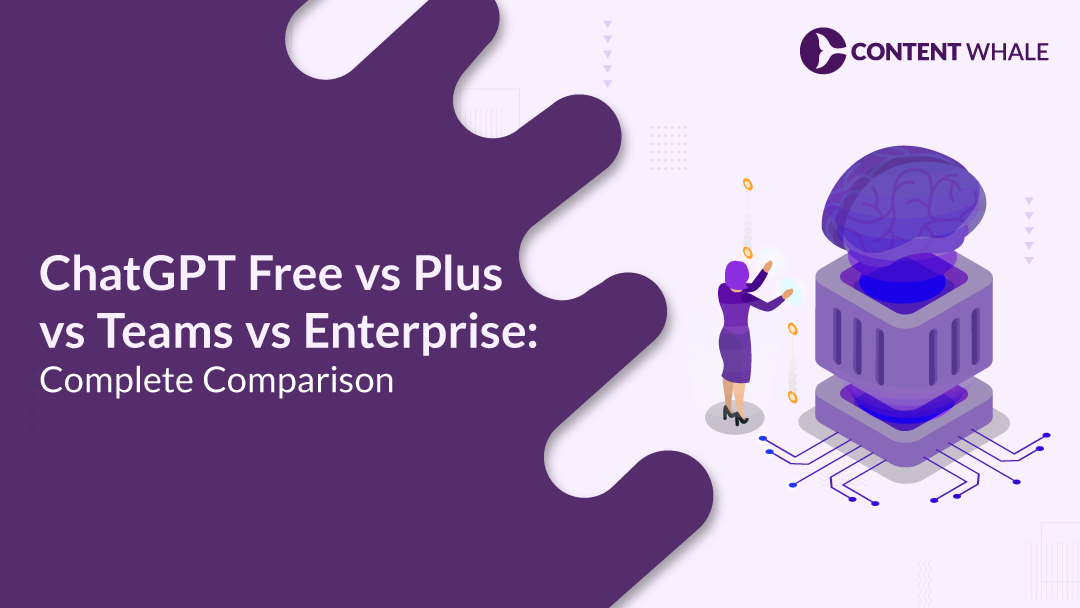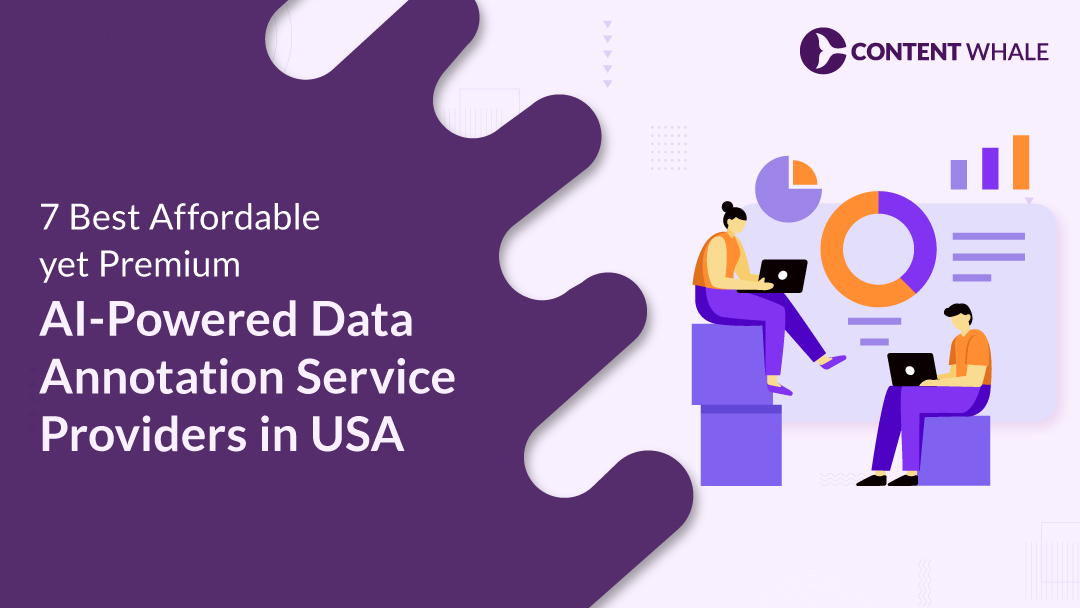When it comes to AI model training, having the right data isn’t just important—it’s everything. Without accurate data annotation, your AI is working with blindfolds on. But here’s the thing: the old, static way of labeling data doesn’t cut it anymore. Enter continuous data annotation for AI. This process feeds your AI dataset with constantly updated, real-world data, ensuring ongoing training data improvement.
The result? Enhanced model accuracy that evolves with time. With annotation tools and a human-in-the-loop approach, you can stay ahead and make sure your AI stays sharp and reliable.
1. What is Continuous Data Annotation?
Continuous data annotation for AI is a method that allows AI models to consistently learn and adapt from fresh data. Unlike traditional one-time annotation, continuous annotation is an iterative and ongoing process. Here’s a breakdown of its key aspects:
a) Dynamic Updates
- Datasets are regularly updated and labeled, ensuring that the AI dataset reflects real-time changes.
- This is particularly valuable for machine learning data labeling, where evolving data impacts model performance.
b) Human-in-the-Loop Approach
- The process leverages both automation and human expertise. While machines handle large-scale tasks, humans ensure quality through manual verification.
- This human-in-the-loop system refines the annotation process and improves model accuracy.
c) Iterative Process
- The iterative annotation process means models are constantly improving by learning from newer data inputs, leading to significant training data improvement over time.
d) Use of Advanced Tools
- Specialized annotation tools streamline the continuous annotation process, making it more efficient and scalable.
2. Key Benefits of Continuous Data Annotation for AI
Continuous data annotation for AI offers several critical advantages for optimizing the performance of AI models. Here’s why this approach is so effective:
a) Improved Model Accuracy
- Continuous updates to the AI dataset ensure that models are trained with the most current and relevant data. This directly improves model accuracy, as the AI becomes better equipped to handle real-world scenarios.
b) Adaptability to Changing Datasets
- AI models often operate in environments where data changes rapidly. Continuous annotation benefits come into play here, enabling the model to stay updated and adapt seamlessly to new data inputs without requiring a complete retraining process.
c) Real-Time Data Processing
- Many industries, such as autonomous driving and healthcare, rely on real-time data annotation. Continuous data annotation ensures that AI systems can respond to live data inputs, making them more effective in decision-making and predictions.
d) Enhanced Training Data Improvement
- The iterative nature of machine learning data labeling allows for constant training data improvement, ensuring that errors are minimized, and the AI learns from updated, more accurate datasets over time.
| # | Benefits | Description | Future Impact |
| 1 | Improved Model Accuracy | Continuous updates to the AI dataset ensure that models learn from real-world data, improving accuracy. | AI models will achieve more precise predictions and better performance across various use cases. |
| 2 | Adaptability to Changing Data | AI models can quickly adjust to new data inputs without requiring a complete retraining process. | Models will be more resilient, adapting to fast-evolving industries like healthcare and e-commerce. |
| 3 | Real-Time Data Processing | Continuous annotation allows AI to work with live, real-time data, improving decision-making abilities. | Future AI systems will respond faster to live inputs, making them suitable for dynamic fields like automation. |
| 4 | Enhanced Training Data Improvement | The iterative annotation process ensures ongoing refinements, reducing errors and improving model quality. | AI models will become more reliable, continuously learning and improving with each data cycle. |
| 5 | Automation with Human Oversight | Combines the power of automation with a human-in-the-loop to handle complex annotation tasks. | Future AI models will operate with greater autonomy while maintaining high quality through human oversight. |
3. How Continuous Data Annotation Works
Continuous data annotation for AI is a dynamic process that ensures ongoing improvement in AI models. Here’s how it operates:
1. Iterative Data Labeling
- The process begins with a structured data annotation process that continuously updates and refines the AI dataset. As new data flows in, it is labeled in real time, feeding back into the AI model for improved learning.
b) Automation and Human Expertise
- Annotation tools play a vital role in automating the labeling of large datasets. However, human input remains essential for handling complex tasks. This combination of automation and the human-in-the-loop ensures high-quality labeling and model accuracy throughout the lifecycle of the AI model.
c) Real-Time Data Updates
- Continuous annotation is especially valuable for industries that rely on real-time data annotation, such as e-commerce and healthcare. The AI model receives constant updates, enabling it to adapt to new patterns and trends quickly.
d) Iterative Improvement
- Through the iterative annotation process, AI models become progressively more accurate. This leads to ongoing training data improvement, as the system refines its understanding of the data with each cycle of annotation.
4. Challenges in Implementing Continuous Data Annotation
While continuous data annotation for AI offers significant advantages, implementing it comes with its own set of challenges. Here’s what organizations often face:
a) Managing Large-Scale Datasets
- As the AI dataset grows, keeping up with the volume of incoming data can be overwhelming. Handling vast amounts of data requires high storage capacity, advanced annotation tools, and a robust infrastructure to support ongoing data annotation processes.
b) Balancing Automation and Human Effort
- Although automation can speed up the annotation process, it’s not flawless. Certain tasks require the involvement of a human-in-the-loop to maintain high model accuracy. Striking the right balance between automated and manual efforts remains a common challenge.
c) Ensuring Data Quality
- The quality of annotations directly impacts AI performance. With continuous annotation, the risk of human error increases as the process scales, which can lead to inaccurate machine learning data labeling. Regular quality checks and iterative improvements are necessary to minimize errors.
5. Best Practices for Continuous Data Annotation
To make the most of continuous data annotation for AI, organizations need to follow a set of best practices that ensure quality, efficiency, and scalability. Here are some key strategies:
a) Leverage Advanced Annotation Tools
- Invest in annotation tools that offer automation, collaboration, and easy integration with machine learning workflows. These tools reduce manual effort and improve the speed of the data annotation process.
b) Implement a Human-in-the-Loop System
- While automation speeds up machine learning data labeling, human expertise is crucial to maintain model accuracy. The human-in-the-loop approach ensures that errors are caught early, and complex cases are handled correctly, allowing for continuous training data improvement.
c) Set Up Quality Control Processes
- Quality checks should be embedded throughout the iterative annotation process. Regular audits, consensus-based labeling, and cross-validation methods help reduce the risk of errors and ensure consistent, high-quality annotations.
d) Integrate Annotation with AI Workflows
- Seamless integration between your annotation tools and AI workflows ensures that the data flows effortlessly into AI model training pipelines. This enables faster iterations and more accurate real-time data annotation.
| # | Best Practices | Description | Impact |
| 1 | Use Advanced Annotation Tools | Invest in robust tools that offer automation, collaboration, and integration with AI workflows. | Increases efficiency, speeds up the annotation process. |
| 2 | Implement Human-in-the-Loop | Combine automation with human oversight for complex data annotation tasks to ensure high quality. | Ensures higher accuracy and reduces errors in AI model training. |
| 3 | Regular Quality Control Audits | Set up continuous audits and reviews to check for annotation consistency and correctness. | Minimizes errors and improves model accuracy over time. |
| 4 | Continuous Dataset Updates | Regularly update your AI dataset to reflect real-time data and trends. | Enhances adaptability and ensures models stay relevant. |
| 5 | Efficient Data Management | Implement scalable data management practices to handle growing datasets efficiently. | Avoids data overload and maintains smooth operations for large datasets. |
| 6 | Provide Annotator Training | Regularly train human annotators to improve their skills and understanding of the annotation tasks. | Improves quality and consistency in the data annotation process. |
6. Tools and Technologies Supporting Continuous Data Annotation
The right tools and technologies are essential for efficiently managing continuous data annotation for AI. Here’s a look at some key options that can streamline the data annotation process:
a) Labelbox
- A leading platform that offers an intuitive interface for machine learning data labeling. Labelbox integrates with AI pipelines, enabling both manual and automated labeling, which improves model accuracy.
b) SuperAnnotate
- Known for its powerful annotation tools, SuperAnnotate is ideal for large-scale projects. It allows real-time collaboration, supports real-time data annotation, and provides detailed analytics to track training data improvement.
c) Appen
- Appen combines human expertise and AI to support the human-in-the-loop approach. It’s widely used for complex datasets that require continuous updates and ongoing iterative annotation processes.
d) Scale AI
- Scale AI specializes in offering automation for large datasets while maintaining high-quality annotations through human oversight. This platform ensures data quality at scale, contributing to continuous AI model training.
Conclusion
Continuous data annotation for AI is the key to maintaining the accuracy and adaptability of AI models. By regularly updating and refining the AI dataset through the data annotation process, businesses can improve model accuracy and keep their systems aligned with real-world data changes. Utilizing annotation tools and a human-in-the-loop approach allows for smooth AI model training while ensuring high-quality machine learning data labeling. Adopting this method offers long-term continuous annotation benefits, making AI models more reliable, efficient, and scalable for real-time applications. Businesses should leverage this strategy to stay competitive and maximize their AI potential.
At Content Whale, we provide top-notch data annotation services designed to enhance AI model training. By utilizing advanced annotation tools and a human-in-the-loop system, we ensure precise, scalable data labeling solutions. Our expertise guarantees improved model accuracy and adaptability. Ready to take your AI projects to the next level? Contact us today to elevate your AI projects!
FAQs
1. What is continuous data annotation for AI?
Continuous data annotation for AI is the process of regularly updating and labeling an AI dataset to ensure that the model stays relevant and accurate as new data becomes available. This method improves the efficiency of AI model training by providing real-time updates that enhance the model’s ability to handle changing data inputs.
2. How does continuous annotation help AI models?
Continuous annotation helps AI models by ensuring that they are always learning from the latest data. This leads to training data improvement and higher model accuracy. The iterative annotation process allows the AI to refine its predictions and perform better in real-world applications, thanks to constant updates and feedback loops.
3. What challenges arise with continuous annotation?
Challenges include managing large volumes of data, ensuring high-quality annotations, and balancing automation with human oversight. While annotation tools can automate much of the machine learning data labeling process, a human-in-the-loop is still needed to handle complex or nuanced cases. Ensuring consistent quality as the dataset grows can also be difficult.
4. What are the best tools for continuous data annotation?
Popular annotation tools that support continuous data annotation include Labelbox, SuperAnnotate, Appen, and Scale AI. These platforms provide automation features and collaborative environments that allow for efficient and accurate data labeling, making them ideal for organizations looking to scale their AI model training efforts.





